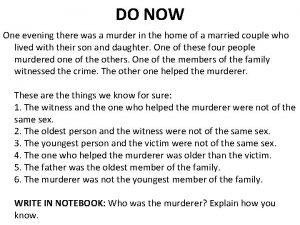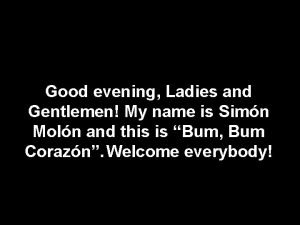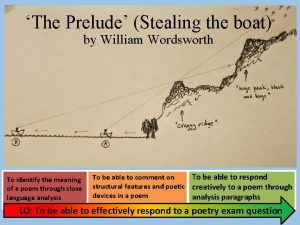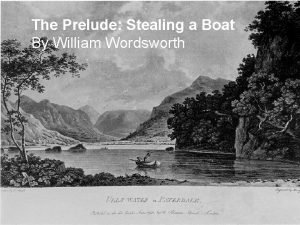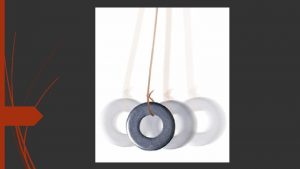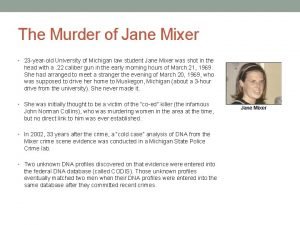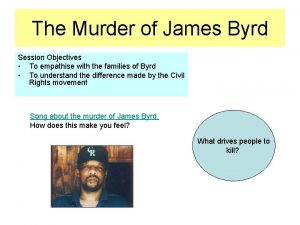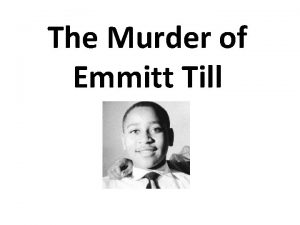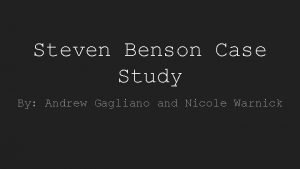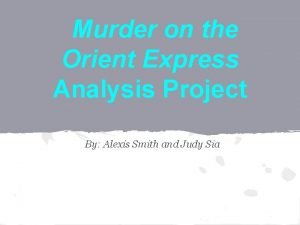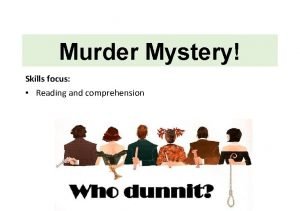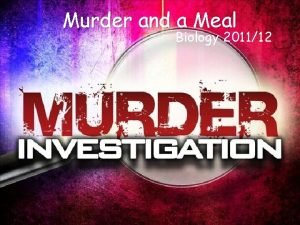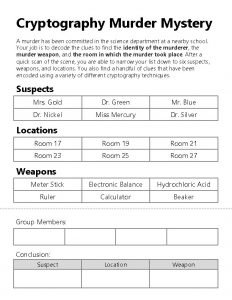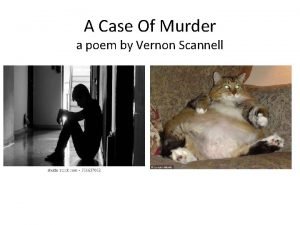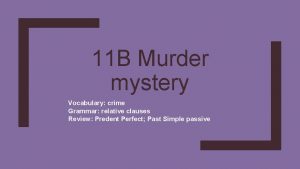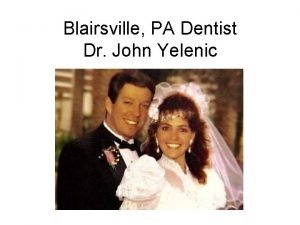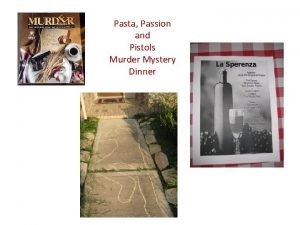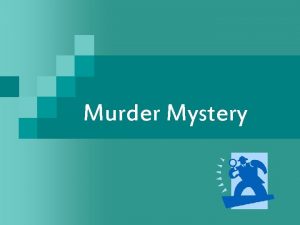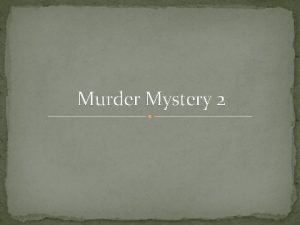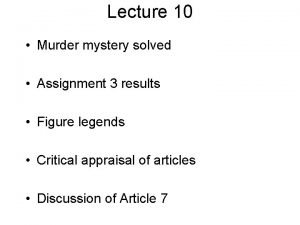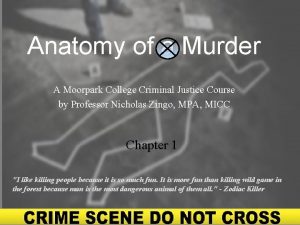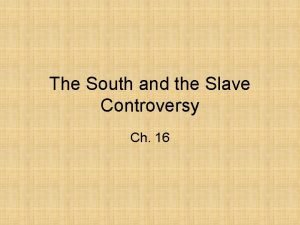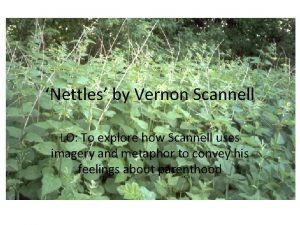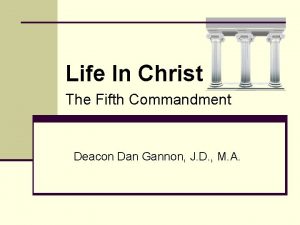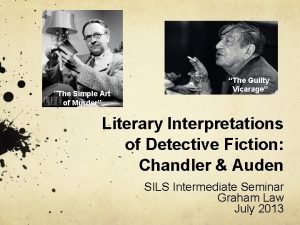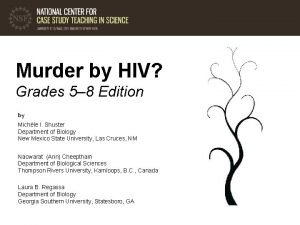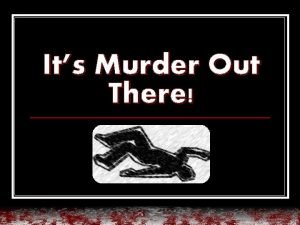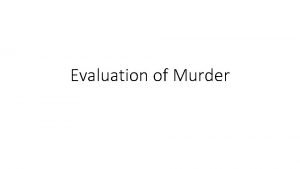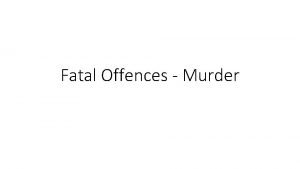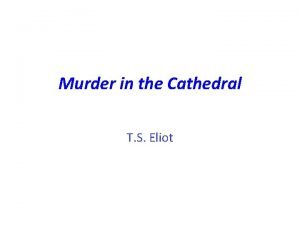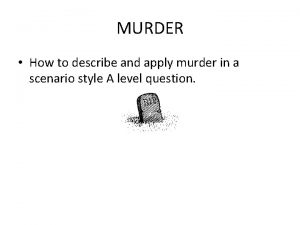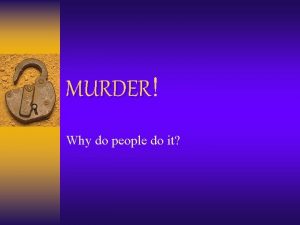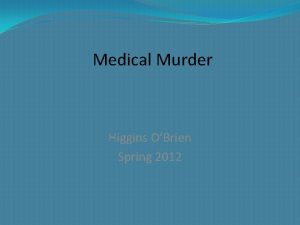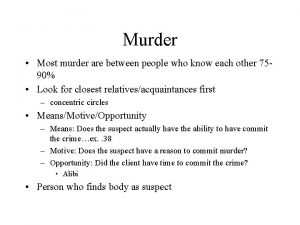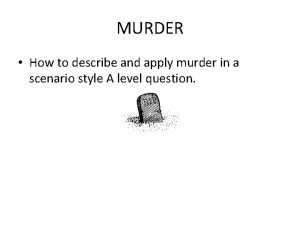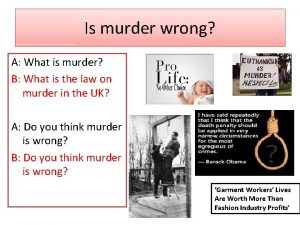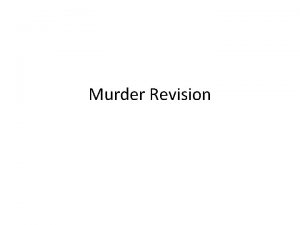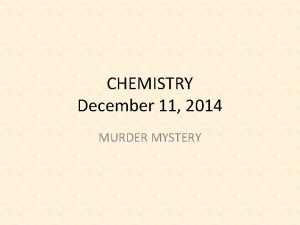DO NOW One evening there was a murder


















































- Slides: 50

DO NOW One evening there was a murder in the home of a married couple who lived with their son and daughter. One of these four people murdered one of the others. One of the members of the family witnessed the crime. The other one helped the murderer. These are things we know for sure: 1. The witness and the one who helped the murderer were not of the same sex. 2. The oldest person and the witness were not of the same sex. 3. The youngest person and the victim were not of the same sex. 4. The one who helped the murderer was older than the victim. 5. The father was the oldest member of the family. 6. The murderer was not the youngest member of the family. WRITE IN NOTEBOOK: Who was the murderer? Explain how you know.

Stand up and walk to the letter of the person who you think committed the murder: A – MOTHER B – FATHER C – DAUGHTER D – SON

signal • After you hear the bell, you have 5 seconds to… … achieve silence … look me in the eyes … remain silent until I give instructions

REACT !!!!!

R. E. A. C. T. R espect everyone E nter and exit appropriately A ccept responsibility C ooperate with everyone T ake action

COMPLIMENTS ALL AROUND Turn to your learning partner and give them a sincere compliment.

LATE WORK I will accept late work until FRIDAY SEPTEMBER 13.

Times to see me Today after school till 4: 30 Friday during lunch

REMINDER Critical analysis 2 is due in 2 weeks. Visit our web site for details.

MONDAY I will not be here. Write in your notebook: 5 words that describe how you will behave on Monday

A SOLUTION We know from (3) that the youngest person was not the victim, from (4) that the youngest person was not the helper and from (6) that the youngest person was not the killer. The youngest person can only have been the witness therefore. If we make up a chart there are now three possible combinations: Oldest person (father) H H M Next to oldest (mother) V M H Next to youngest (son) M V V Youngest (daughter) W W W (H = Helper ; V = Victim ; M = Murderer ; W = Witness)

A SOLUTION PART 2 We can work out from (5) that the father was the oldest, from (2) that the youngest person must have been the daughter. Therefore the next to the youngest must have been the son and the next to the oldest, the mother. Of three possibilities: the first is impossible (from (3) – the youngest person and the victim were of different sexes); the third is also impossible (from (1) – the witness and the helper were of different sexes). Therefore only the second possibility holds – and the mother was the murderess

Expert and Eyewitness Testimony

Explain how eyewitness testimony and expert testimony are utilized in crime investigations

Landmark Cases • Frye v. United States – discussed what is meant by a technique that is “generally accepted” by most of the scientific community. • Federal Rule of Evidence 702 - deals with admissibility of expert testimony • Daubert v. Merrell Dow Pharmaceutical, Inc. allows trial judge to decide who is and who is not an expert witness.

Landmark Cases • Coppolino v. State – recognized the admissibility of new techniques as long as they are based on scientifically valid principles and techniques.

Expert Testimony • If a witness can establish to the satisfaction of a trial judge they are an expert, their testimony can be considered “expert”. • Absolute certainty – never possible. Usually an opinion is given probabilities and statistical chances. • Forensic scientist does not testify for the defense or the prosecution. They testify only to the truth as they can ascertain it.

Typical Expert Witnesses • Forensic Pathology – Investigation of sudden, unnatural, unexplained or violent deaths • Forensic Anthropology – Identification of human skeletal remains • Forensic Entomology – Study of insects and their relations to a criminal investigation • Forensic Psychiatry – Relationship between human behavior and legal proceedings is examined • Forensic Odontology – Characteristics of teeth used to ID body • Forensic Engineering – Reasons for structural failure and where the responsibility might fall.

EYEWITNESS TESTIMONY

Witnesses vs. Physical Evidence • Most witnesses do not intentionally lie on the witness stand • Human observation is limited by memory, suggestion, and interpretation • Memories can be confused or altered, but physical evidence stays the same

Definitions • Observation: what we experience directly from our 5 senses (hear, touch, taste, smell, see) • Perception: interpreting information received from the senses

WRITE 5 OBSERVATIONS 5 people will share

WRITE 5 DETAILS YOU NOTICE IN THIS IMAGE 5 people will share 1 2 3 4 5

Write down two perceptions about this scene.

STAND UP and COMPARE your perceptions with your learning partner’s… Were they the same? Different? Could your assumptions be wrong? How would you know if they were wrong or right? Sit down when y’all have answers to these questions. 3 people will share

Our Brain: • Filters out information • Fills in gaps in information • Applies previous knowledge to new situations

How To Be a Good Observer 1. Make a conscious effort to examine environment systematically. 2. Observe everything. Pay attention to details. Turn off filters. 3. Gather information first before starting to analyze or interpret it. 4. Write down and photograph and video as much as possible. Document!

Eyewitness Accounts • Provides direct evidence to crime scenes • Perceptions can be faulty • Observations affected by: – – – – emotional state level of interest stress concentration amount/kind of distraction prejudice personal beliefs motives

A Case of Mistaken Identity? The Psychology of Eyewitness Testimony 1) Read the questions at the end of the article. 2) Read the article 1) Circle confusing words 2) Highlight or underline key phrases that will help you answer the questions. 3) Write the answers in your notebook.

A Case of Mistaken Identity? The Psychology of Eyewitness Testimony Compare your question 1 response with your learning partner. When the two of you are ready to share with the class, stand up.

Problem • You’ve discovered a problem with the crime scene photos from a recent case. Someone has tampered with the crime scene. See how many differences you can spot between the two photographs of the same crime scene.

INDIVIDUALLY, Write down the differences you see.

Did you find 5 differences?

I-Witness

Problem • You were the principle crime scene investigator on a case two years ago. • It is now time for you to testify in court about your findings. • The defense attorney challenges the accuracy of your testimony and implies that you observational skills are not so great.

• If he can show the jury you are not good at spotting details, he might have a chance of getting his client off. • It is often the case in real life situations that the credibility of expert witness testimony is challenged. • The thoroughness with which they do their jobs is critical.

Can you prove your observational skills are excellent? Let’s test them on the next slide.

Memory Quiz • In your notebook, number your paper from 110. • You will have 10 seconds to memorize the following photograph.

You have 10 seconds to memorize the picture below.

1. What color coffee mug was in the picture? • • Blue Red Yellow White

2. When was the deadline? • • Yesterday Tomorrow Today Oct. 19

3. What time was on the clock on the wall? • • 10: 40 7: 20 5: 38 11: 05

4. How many sticky notes were on the whiteboard? • • 3 6 7 8

5. Which of the following was NOT in the picture? Stapler Printer Trash can Pen

6. What was the name on the plaque on the desk? Steve Brian David Jeff

7. What color was the victim’s shirt? White Blue Red Green

8. How many plants were in the picture? • • 0 1 2 3

9. Which of the following was on the floor? Coffee mug Plant Cardboard box Backpack

10. Where was the book in the picture? • • On the box On the desk On the floor Under the body

Answers 1. 2. 3. 4. 5. Yellow Today 11: 05 6 Stapler 6. Brian 7. Blue 8. 2 9. Backpack 10. On the box
 Mathematics john's favourite subject
Mathematics john's favourite subject One evening there was a murderer answer
One evening there was a murderer answer Ladies and gentlemen it my pleasure to introduce to you
Ladies and gentlemen it my pleasure to introduce to you Gentlemen good night ladies good morning
Gentlemen good night ladies good morning Now i see it now you don't
Now i see it now you don't Boat stealing william wordsworth analysis
Boat stealing william wordsworth analysis Prelude boat stealing
Prelude boat stealing Therefore there is no condemnation
Therefore there is no condemnation One empire one god one emperor
One empire one god one emperor One one one little dog run
One one one little dog run One king one law one faith
One king one law one faith Byzantine definition
Byzantine definition One ford plan
One ford plan See one do one teach one
See one do one teach one One price policy
One price policy Structure of twelfth night
Structure of twelfth night See one do one teach one
See one do one teach one Asean tourism strategic plan
Asean tourism strategic plan One vision one identity one community
One vision one identity one community The raven text
The raven text Gary leiterman young
Gary leiterman young Donald byrd murder
Donald byrd murder The murder of emmitt till date
The murder of emmitt till date Steven benson murder
Steven benson murder Cliff notes murder on the orient express
Cliff notes murder on the orient express Murder mystery reading comprehension
Murder mystery reading comprehension Murder and a meal
Murder and a meal A murder has been committed
A murder has been committed A case of murder by vernon scannell
A case of murder by vernon scannell Predent perfect
Predent perfect Zechariah stevenson sentenced
Zechariah stevenson sentenced What does teiresias say when he arrives?
What does teiresias say when he arrives? Murder mystery inference activity
Murder mystery inference activity Julie wills murder
Julie wills murder Silvia lugo murder
Silvia lugo murder Dr john yelnick
Dr john yelnick Bo jalais character background
Bo jalais character background Cryptography murder mystery answers
Cryptography murder mystery answers Murder mystery 2 background
Murder mystery 2 background Murder mystery assignment
Murder mystery assignment Murder drones b
Murder drones b Murder suicide moorpark
Murder suicide moorpark The scourged back
The scourged back Julius caesar act three summary
Julius caesar act three summary Pmf skopje
Pmf skopje Nettles poem questions and answers
Nettles poem questions and answers Macbeth dagger soliloquy
Macbeth dagger soliloquy Abortion is murder
Abortion is murder The guilty vicarage
The guilty vicarage Murder on the orient express vocabulary
Murder on the orient express vocabulary Murder by hiv
Murder by hiv

